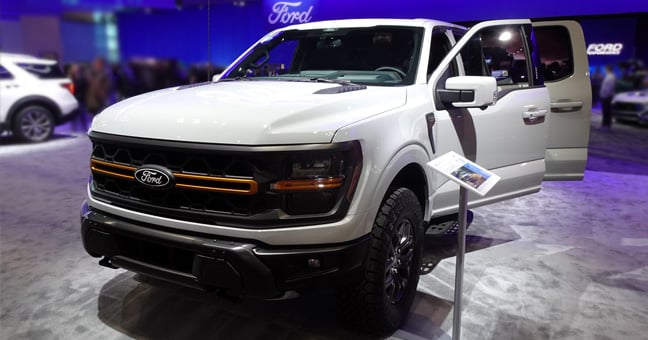

Jul 31 2025
By Haylee Eaton
Domestic pickup trucks continue to dominate the U.S. automotive market, with Ford leading the pack year over year. The Ford F-Series has been the best-selling truck line in the country for decades, with approximately 732,100 units sold in 2024 alone. These popular vehicles are also among the most highly customizable on the market, offering a wide range of trims, packages, and configurations, which makes accurate, build-level data more critical than ever.
Access to complete vehicle build data, which describes precisely how each vehicle was configured at the factory, has always been in high demand, and this is especially true for Ford. Even after reducing buildable configurations by about 90% for the 2024 model year, the 2024 Ford F-150 had 81 combinations of trim, cab, drive type, bed length, and engine (as detailed in the 2024 model year Ford F-150 Order Guide), with dozens of equipment packages and options for many of these configurations. This complexity has made Ford vehicles difficult to work with in an environment where Ford Build Data was very difficult to acquire for all but a few businesses.. Since its introduction into the market in more recent years, companies across the automotive industry now look to Ford build data for better insights for their operations, ways to enhance the precision of online listings, and solve loss ratio challenges associated with efficiently and precisely identifying loss and comp vehicles. These stakeholders are prioritizing deeper, more granular information for Ford vehicles, especially its pickup line, and the reason behind this shift is clear.
Ford’s dominant market share in pickups and vans, combined with unmatched build complexity, makes its vehicles a top priority for businesses seeking accurate, actionable data.
Ford’s work-focused trucks and vans, especially popular lines like the F-150, Super Duty, and Transit, are among the most configurable vehicles on the road. In many cases, a single VIN pattern can map to dozens of build combinations, varying by trim level, cab style, bed length, axle ratio, and drivetrain. Factoring in factory-installed options and colors, this turns into many thousands of possible configurations. Without access to the full build sheet, it is easy to misidentify a truck’s trim or miss high-value optional features like towing or payload packages, technology upgrades, or driver assist systems. This can lead to inaccurate appraisals, returned parts, or insurance misquotes, especially when VIN-level data alone doesn’t narrow down the configuration. In some cases, a vehicle‘s base VIN pattern may return multiple trims with a price range difference of over $30,000, even before factory-installed options are considered.
This matters because:
Without a build sheet, vehicles can be easily misclassified, and capabilities can be miscalculated, which creates risk, lost time, and increased expenses or lost revenue across many use cases.
DataOne helps bridge the gap between standard VIN decoding and build-level vehicle data. When Ford build data is available, DataOne identifies exactly how a vehicle was configured at the factory, surfacing the specific options, packages, and features to make it clear what is and is not installed.
This build data is delivered in a standardized, structured format that integrates efficiently into business systems. DataOne provides a layer of information that goes beyond the OEM “marketing speak” and normalizes features into consistent, easily consumable categories. Delivered via API, this data supports real-time vehicle lookups and daily updates, helping businesses improve accuracy, reduce risk, and streamline operations.
As Ford vehicles continue to dominate both retail and commercial markets, demand for accurate build data will only increase. Businesses that rely solely on VIN pattern decoding will find themselves at a competitive disadvantage. The real question is: how long can you continue to make critical decisions without complete information? No matter what part of the automotive ecosystem you serve, having the full picture of a Ford vehicle’s make-up gives you a critical edge.
DataOne’s build data solutions enable organizations relying on clear, accurate, and actionable vehicle data to stop guessing and start knowing. Click the button below to get in touch with one of our business development representatives.